Short Wave Quartz Emitters are the infrared emitters with the highest radiation intensity (up to 20 W/cm²). They consist of coiled tungsten wire within an air-tight quartz glass filled with inert gas. Depending on the requested emission range, differently coiled heating coils are used. We also supply various holders and connections as required.
Heating and cooling times last only a few seconds. Thus these heaters are most suitable for applications with short cycle times that have to be either started or cooled down quickly.
Reflectors made of aluminised steel sheet are available matching the emitters. To adjust the radiation even more accurately to the target material the glass can also be equipped with a coating made of ceramics or gold on the rear.
The standard products that can be supplied within a short lead time are shown in the tables below. Starting at 25 pieces we are pleased to manufacture special emitters upon your request. We can also manufacture twin tube emitters with a one-sided connection. Moreover, these twin tubes have a higher autostability which allows for a longer length of tube. We can also bend the emitters with a minimum bending radius of 20 mm (twin tubes: 150 mm) according to your specifications.
These emitters are generally designed for horizontal installation positions. A diagonal or vertical operation of the emitter is possible via a special support of the heating coil at the quartz glass (see our operating instructions).
 The high light ratio can also present some issues in some applications. Ruby-coloured glass therefore shades the light ratio without influencing the infrared radiation output.
The high light ratio can also present some issues in some applications. Ruby-coloured glass therefore shades the light ratio without influencing the infrared radiation output.
In order to optimize the lifetime of the emitters and reflectors we recommend an air cooling operation. Temperatures above 350 °C in the areas of the element's cold ends should be avoided in any case.
Choose from our Short Wave Quartz Emitters between these models:
- Quartz Halogen Emitters
- Quartz Tungsten Emitters
- Twin Tube Infrared Emitters
- Short-wave IR-systems & Accessories
Quartz Halogen Emitters
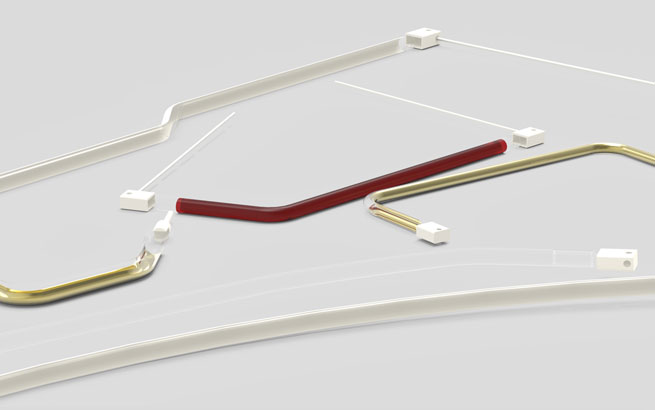 Curved quartz halogen emitters (with FCB connection)
Curved quartz halogen emitters (with FCB connection)
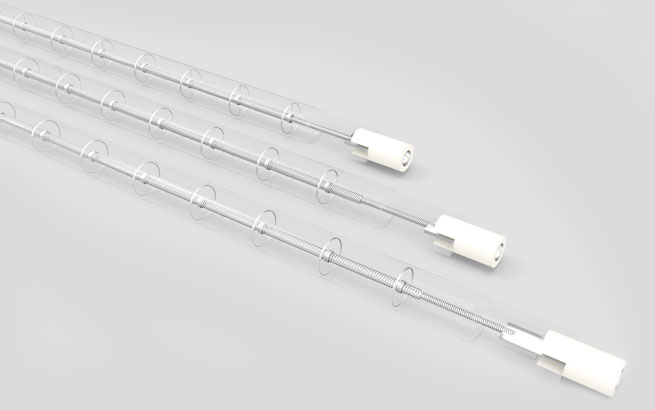 Quartz Halogen Emitter with R7s termination
Quartz Halogen Emitter with R7s termination
With Quartz Halogen Emitters the tungsten coil is kept in the middle of the quartz tube by means of distance clips. This distance to the glass is necessary as the heating wire can reach up to 2600 °C. Due to the high coil temperature these heatings emit up to 5 % radiation in the visible range (yellow to white light). We recommend installing the emitters so that they are shielded from plain sight. In the standard version the emitter may only be operated horizontally. Emitters for the vertical operation can only be manufactured upon request.
Quartz Halogen Emitters standard
- Connection: R7s
- Colour: clear glass
- Thermocouple: not possible
- Fixing: via connection
- Dimension: Ø 10 mm
length see table - Voltage/Power: 240 V / see table
Quartz Halogen Emitters option
- Connection: others possible
- Colour: red, ceramic or gold coated glass
- Thermocouple: none
- Fixing: none
- Dimension: others possible
max. length 1200 mm
(twin tube: 23 x 11 mm or 33 x 15 mm, up to 3000 mm) - Voltage/Power: others possible
| Type | Power (at 240 V) | Max. coil temp. | Total length | Heated length | Tube Ø | ||||||||||||||||||||||||||||||||||||||||||||||||||||||||||||||||||||||||||||||||||||||||||||||
|---|---|---|---|---|---|---|---|---|---|---|---|---|---|---|---|---|---|---|---|---|---|---|---|---|---|---|---|---|---|---|---|---|---|---|---|---|---|---|---|---|---|---|---|---|---|---|---|---|---|---|---|---|---|---|---|---|---|---|---|---|---|---|---|---|---|---|---|---|---|---|---|---|---|---|---|---|---|---|---|---|---|---|---|---|---|---|---|---|---|---|---|---|---|---|---|---|---|---|---|
| Here you can find Reflectors and Holders for Quartz Halogen Emitters. | |||||||||||||||||||||||||||||||||||||||||||||||||||||||||||||||||||||||||||||||||||||||||||||||||||
| QHS | 750 W | 2410 °C | 224 mm | 170 mm | 10 mm | ||||||||||||||||||||||||||||||||||||||||||||||||||||||||||||||||||||||||||||||||||||||||||||||
| QHM | 1000 W | 2410 °C | 277 mm | 235 mm | 10 mm | ||||||||||||||||||||||||||||||||||||||||||||||||||||||||||||||||||||||||||||||||||||||||||||||
| QHL | 1500 W | 2250 °C | 473 mm | 425 mm | 10 mm | ||||||||||||||||||||||||||||||||||||||||||||||||||||||||||||||||||||||||||||||||||||||||||||||
| QHL | 2000 W | 2390 °C | 473 mm | 425 mm | 10 mm | ||||||||||||||||||||||||||||||||||||||||||||||||||||||||||||||||||||||||||||||||||||||||||||||
Quartz Tungsten Emitters
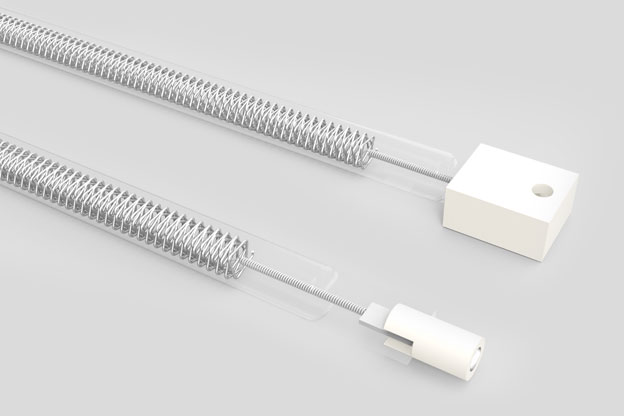
A star-shaped heating coil supports itself at three points in the glass of the Quartz Tungsten Emitters. This makes for excellent structural stability. The direct contact with the glass is only made possible because the heating coil's temperature does not exceed 1500 °C. At the same power considerably more heating coil is used than at emitters with a supported coil. Thus the emitted radiation is not that short-waved. Furthermore, a ratio of visible light is radiated. However, this is more in the orange to dark-yellow range.
Quartz Tungsten Emitters standard
- Connection: R7s
- Colour: clear glass
- Thermocouple: not possible
- Fixing: via connection
- Dimension: Ø 10
length see table - Voltage/Power: 240 V / see table
Quartz Tungsten Emitters option
- Connection: others possible
- Colour: red, ceramic or gold coated glass
- Thermocouple: none
- Fixing: none
- Dimension: others possible
max. length 1200 mm
(twin tube: 23 x 11 mm or 33 x 15 mm, up to 3000 mm) - Voltage/Power: others possible
| Type | Power (at 240 V) | Max. coil temp. | Total length | Heated length | Tube Ø | ||||||||||||||||||||||||||||||||||||||||||||||||||||||||||||||||||||||||||||||||||||||||||||||
|---|---|---|---|---|---|---|---|---|---|---|---|---|---|---|---|---|---|---|---|---|---|---|---|---|---|---|---|---|---|---|---|---|---|---|---|---|---|---|---|---|---|---|---|---|---|---|---|---|---|---|---|---|---|---|---|---|---|---|---|---|---|---|---|---|---|---|---|---|---|---|---|---|---|---|---|---|---|---|---|---|---|---|---|---|---|---|---|---|---|---|---|---|---|---|---|---|---|---|---|
| Here you can find Reflectors and Holders for Quartz Tungsten Emitters. | |||||||||||||||||||||||||||||||||||||||||||||||||||||||||||||||||||||||||||||||||||||||||||||||||||
| QTS | 750 W | 1450 °C | 224 mm | 170 mm | 10 mm | ||||||||||||||||||||||||||||||||||||||||||||||||||||||||||||||||||||||||||||||||||||||||||||||
| QTM | 1000 W | 1450 °C | 277 mm | 225 mm | 10 mm | ||||||||||||||||||||||||||||||||||||||||||||||||||||||||||||||||||||||||||||||||||||||||||||||
| QTL | 1500 W | 1270 °C | 473 mm | 415 mm | 10 mm | ||||||||||||||||||||||||||||||||||||||||||||||||||||||||||||||||||||||||||||||||||||||||||||||
| QTL | 2000 W | 1500 °C | 473 mm | 415 mm | 10 mm | ||||||||||||||||||||||||||||||||||||||||||||||||||||||||||||||||||||||||||||||||||||||||||||||
Twin Tube Infrared Emitters
 Twin Tube Infrared Emitters
Twin Tube Infrared Emitters
 bent twin tube emitter with gold reflector
bent twin tube emitter with gold reflector
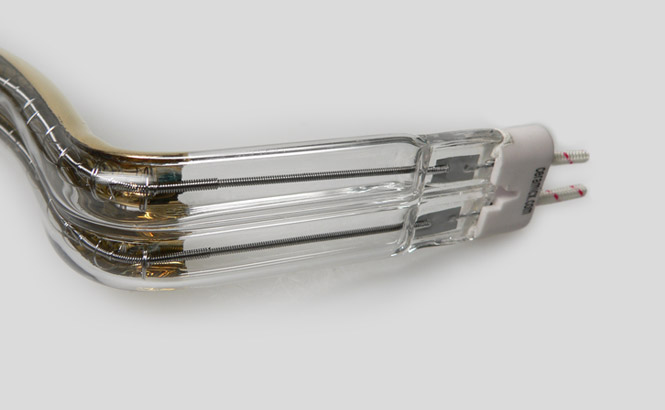 termination area of bent twin tube emitter
termination area of bent twin tube emitter
Our short-wave quartz halogen and quartz tungsten emitters are also available as twin tube emitters, in the cross-sections: 23 x 11 mm and 33 x 15 mm.
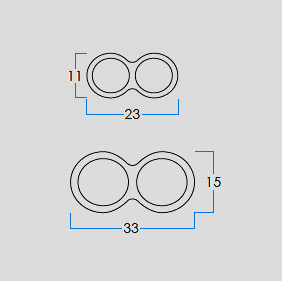
Much higher power densities can be achieved with a twin tube emitter than with conventional emitters. The twin tube emitter is therefore predestined for particularly high process speeds. Due to the "rectangular" design, the infrared radiation also has a more homogeneous effect over the surface.
Due to the larger cross section, the mechanical stability of the twin tube emitters is greater than that of the single tube emitters. Therefore longer emitters can be produced (up to 3000 mm).
Like the single tube emitters, the twin tube emitters radiate in all directions. If this is not desired, reflective coatings of ceramic or gold can be applied to "direct" the radiation to where it is needed.
The twin tube emitters can be manufactured with either a double-sided or a single-sided connection. Especially in applications with limited space this means a significant simplification for the design.
Twin tube emitters are, for example, ideal for paint drying in the automotive industry or for extreme heat tests, e.g. in the aerospace industry. Since the electrical connected load is converted into radiant heat virtually without delay, the radiators reach their maximum temperature in seconds.
Twin tube radiators are manufactured exclusively according to the requirements of our customers. The minimum order quantity is 10 pieces.
Like all heating elements supplied by us, the twin tube radiators naturally also bear the CE mark.
Twin Tube Infrared Emitters Standard
- No standard
Twin Tube Infrared Emitters Options
- Connection: single side or double side
- Wave length: short wave or fast medium wave
- Colour: clear glass
- Coating: reflective ceramic- or gold caoting
- Thermocouple: not possible
- Fixing: via connection
- Dimension: 23 x 11 mm or 33 x 15 mm, max. length 3000 mm
- Form: custom made, min. bending radius: 150 mm
- Voltage/Power: custom made
Short-wave IR-systems & Accessories
FAST-IR Units
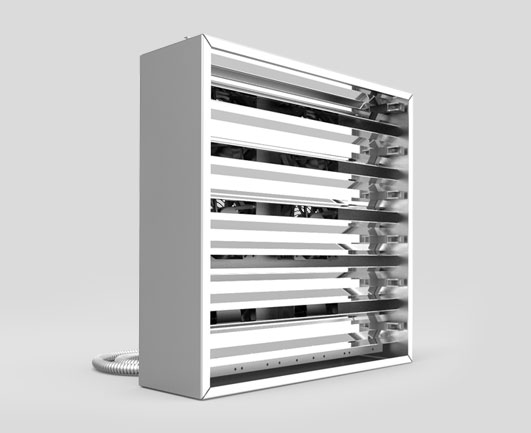
FastIR 500
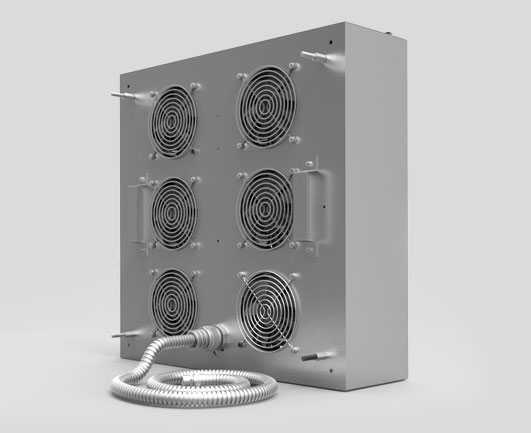
FastIR 500
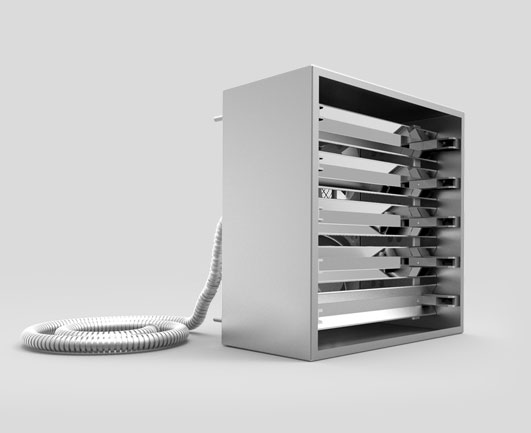
FastIR 305

FastIR 305
A standardized unit for using quartz halogen or quartz tungsten emitters is the FAST-IR unit. The reflectors are installed in a light-weighted but sturdy cabinet with integrated aeration. The units can be used in a variety of versatile applications: from paint drying to pre-heating of foils up to printing or thermoforming of textiles, leather and synthetic leather in the furniture and automotive industries.
Both short-wave emitter types, quartz halogen with supported coil or quartz tungsten with star-coil can be used in our Fast-IR units.
The installed axial fans are designed for continuous operation. Besides cooling the reflectors and emitters the directed air stream also serves for evacuating humidity and gases arising from applications that would disturb the heating process.
In addition to the standard sizes we also manufacture various unit dimensions on request. For larger systems several Fast-IR units can be strung together.
| Type | Dimensions | Emitters | Power (at 240 V) | Power density | Drawings |
|---|---|---|---|---|---|
| FastIR 305 | 305 x 305 x 150 mm | QTM or QHM, 1000 W | 4 emitters: 4 kW 5 emitters: 5 kW |
4 kW » 43 kW/m² 5 kW » 54 kW/m² |
Drawing
Drawing |
| FastIR 500 | 500 x 500 x 150 mm | QTL or QHL, 1750 W, 2000 W |
6 emitters: 12 kW 7 emitters: 14 kW |
12 kW » 48 kW/m² 14 kW » 56 kW/m² |
Drawing
Drawing |
Control
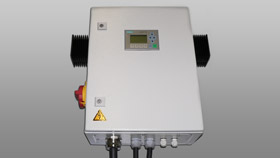 For the short wave quartz emitters a PLC-based control with high-performance semiconductor relays has been developed. Besides the standard control technology it is also equipped with a preheating programme for the emitters, a standby-control as well as an after-running control for the FAST-IR units' fans. It can also be controlled via a time-preset. The LC-display guarantees a high ease of use.
For the short wave quartz emitters a PLC-based control with high-performance semiconductor relays has been developed. Besides the standard control technology it is also equipped with a preheating programme for the emitters, a standby-control as well as an after-running control for the FAST-IR units' fans. It can also be controlled via a time-preset. The LC-display guarantees a high ease of use.
Accessories
Reflectors

For standard emitters we can supply matching reflectors made of aluminized steel. Installation is very easy: screw the reflector, fix the emitter, ready. Special designs can be manufactured without any problems.
These reflectors can also be made of stainless steel. The reflectors are supplied with R7s-holders and connecting wires.
| Type | Matching | Dimension |
|---|---|---|
| QTSR | QTS / QHS | 250 x 62 mm |
| QTMR | QTM / QHM | 300 x 62 mm |
| QTLR | QTL / QHL | 497 x 62 mm |
Téléchargements:
-
Flyer - Looking for contactless heating?

Freek offers long-wave, medium-wave und short-wave infrared emitters!
-
Really hot! Our Product Flyer.

Download our leaflet here.


